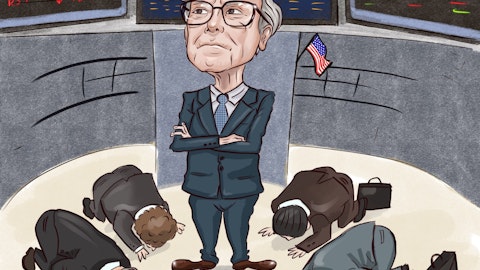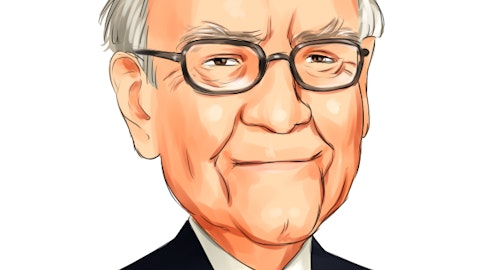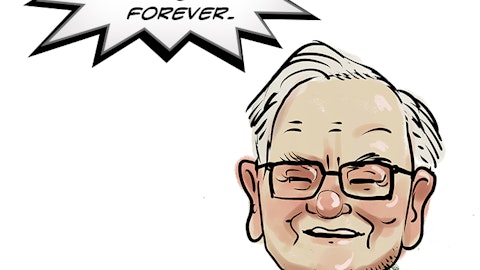Soomit Datta: Two for me, please. One is just on the funding cost. I think you’ve talked about normalizing the duration of receivables. I mean this seems to make quite a big difference to the funding cost. I wondered just whether there was any difference in the level of kind of prepayment of TPV. And also wondered, I think when you talked about adjusting the duration of receivables in the second quarter have been around a slightly more cautious macro outlook. But when I look at your TPV guidance, we’ve kind of discussed on this call and when I take into account what’s happened to the acquiring TPV market in Q3, which I think was down on Q2, it feels like there’s a cautious outlook on the macro. But again, that doesn’t seem reflected quite in the way you’re kind of funding the prepayment. So it would be helpful just to get some clarity around that, please.
Rafael Martins: Sure, Soomit, Rafael here. So I think that first, if we look at our liabilities, they have longer duration than our assets in prepayment business. So I think we are already conservative in the way we deal with our capital structure. Also, we have generated significant cash over the last year. And if we think about the amount of cash balance we had sit on balance sheet was a little over R$6 billion last quarter, and I think that we had, and we saw a space to keep being conservative and high liquidity levels, but also be a little more efficient in the way we fund the prepayment business. So I think that we’re always looking at to be more efficient in that capital structure management. And of course, in the fourth quarter TPV trends that we saw, it does have some effects that shouldn’t be recurring effects regarding World Cup. So I think that this is sort of the financial expenses dynamics this quarter. I don’t know, Thiago, would like to add?
Thiago Piau: Yes, Rafa, please. So Soomit, Thiago here. Just to help you understand trends, our prepayment business continued to perform very well. And as Rafa said, we think that in the short term, we still have space for funding cost to grow less than revenue from prepayments. But over time, we think that the funding cost should grow in line with TPV and the CDI rate. So short term, we think that it will grow less in revenue. Over the medium term, it should grow in line with TPV and CDI rates.
Soomit Datta: Okay, that’s very helpful thank you.
Thiago Piau: Thank you very much, Soomit.
Operator: And our next question will come from Pedro Leduc with Itaú BBA. Please go ahead.
Pedro Leduc: Thank you, good evening. Thank you for taking the question. A little bit on the banking side of things, thinking about your broader ecosystem, there for SMEs. You’ve mentioned deposits, R$2.7 billion. If you can give us a little bit of color on what the profile is, how fast they turn. And of course, you reinforced the banking team, you will increase product features as we think about Stone Bank in 2023, what do we think about products, the client profile, SMEs I imagine. And you also reignited your credit, you’re still piloting it. But if you can give us a rough sense on how big of a loan book it could be in 2023 by the end, assuming it goes well. It would be much appreciated. Thank you.
Thiago Piau: Hi Pedro, Thiago here. I will start, and then I will pass it over. Thank you for the question. I think that regarding banking, what we can say is that today, banking is basically focused on the SMB. We still have space to continue to grow our banking client base in the SMB space because of the client base we have in payments, and we still have room to increase the engagement of our clients with our solutions as we rolled over more functionalities. Today, our clients, they still have to use bank accounts from other players because we are still lacking some functionalities. I think that once we have the full feature that we have planned to the segment, the engagement will increase, and this will produce better results.
More than this, we are now moving our attention to provide more banking solutions to micro merchant space. Because Stone today has a very limited account, so we are not taking account in our numbers, clients from micro merchants. Once we expand our offering of banking to micro merchants that we create positive effects both on total standing balance revenues from interchange from the cards and activation of PIX. So there is a positive movement towards next year of moving banking towards the micro merchant space. So we see this as a very big avenue of growth for 2023. Lia, do you want to complement, please?
Lia Matos: Yes. Just some quick additional comments. I think Thiago said most of this, Pedro. The evolution in deposits came from naturally the growth in the number of accounts, but also average outstanding balance per client increasing as well. So a lot of work to do there to increase the feature set, to increase engagement that we’re already seeing very positive traction within SMB. I think one additional color regarding opportunity is we’re excited to opportunity within Linx space, so integrating banking to the ERP of Linx clients. It’s still early stages. So although the absolute number of clients is small, we’re seeing very positive feedback from clients because this is an integration that really adds tangible value to facilitating client workflows, helping them better manage cash flows, automate their financial processes in a much better way.
So that’s the only additional color that I would give. I think our focus €“ our big focus right now is on SMB client base and selling banking into Ton client base, but we see a big future opportunity within PIX client base as well.





